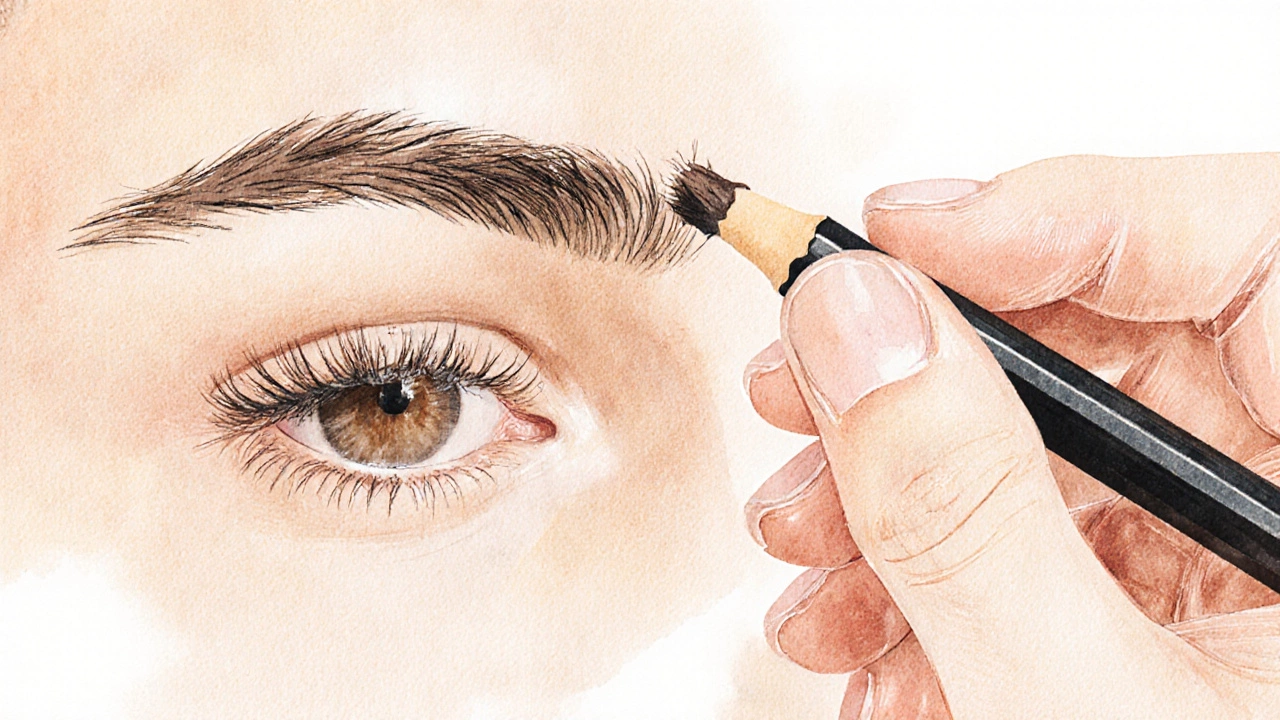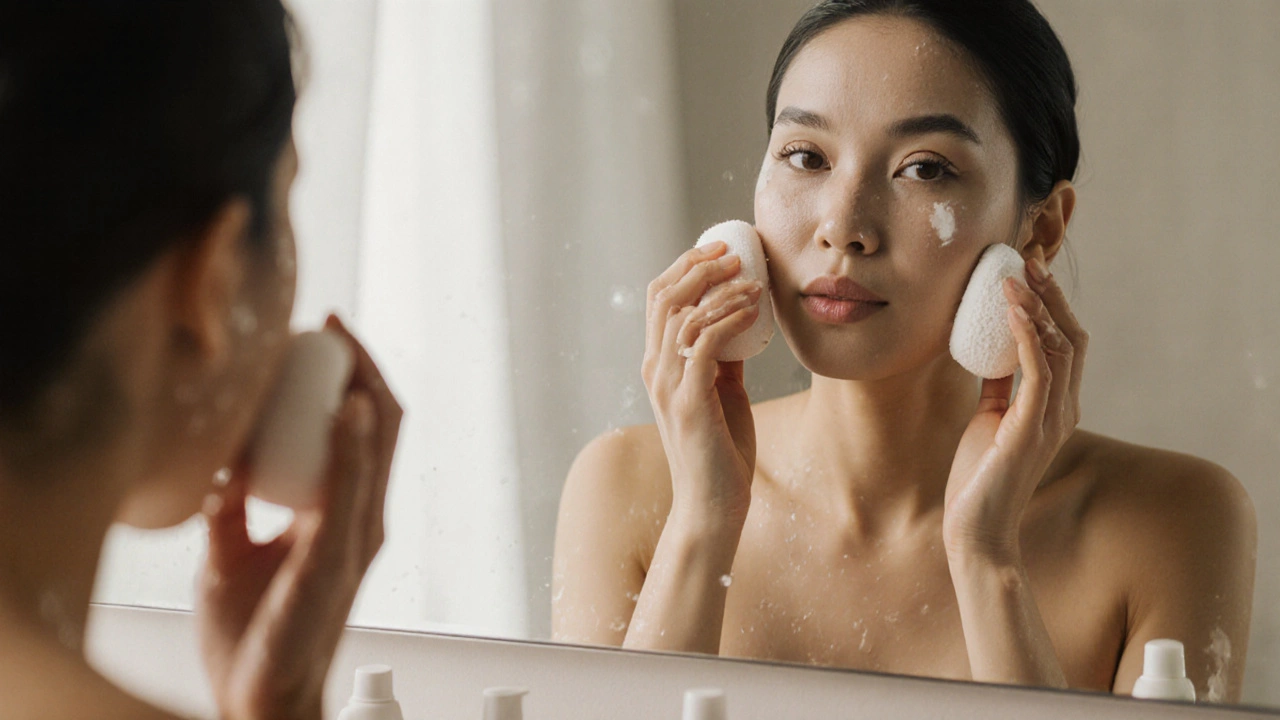Everyday Makeup Time Calculator
How long does your basic makeup routine take? This calculator helps you estimate the time needed based on the steps you include.
Want to look put together without spending an hour in front of the mirror? Basic makeup doesn’t have to mean heavy foundation, thick eyeliner, or five different products. It’s about enhancing what you already have-clean skin, natural color, and a little definition. If you’ve ever felt overwhelmed by makeup tutorials that feel more like a stage performance than a morning routine, this is for you.
Start with Clean, Moisturized Skin
Makeup sits better on skin that’s ready for it. Skip the skip-the-moisturizer myth. Even if you have oily skin, skipping hydration makes your skin produce more oil to compensate. Use a lightweight, non-comedogenic moisturizer. Wait two minutes after applying it before moving on. This lets the product sink in so your foundation doesn’t slide off by noon.Don’t overdo it. A pea-sized amount is enough for your whole face. If you’re in a hurry, use a moisturizer with SPF. You don’t need a separate sunscreen if your moisturizer has SPF 30 or higher. Just make sure you’re applying enough-you need about a teaspoon for your face and neck.
Use a Light Coverage Foundation or Tinted Moisturizer
You don’t need full-coverage foundation for everyday. In fact, heavy foundation often looks cakey, especially under natural light. Try a tinted moisturizer or a light-coverage BB cream. These give just enough evenness to blur redness, minor blemishes, or uneven tone without looking like you’re wearing a mask.Apply with your fingers or a damp sponge. Fingers warm the product, helping it blend into your skin naturally. Dab it on your forehead, cheeks, nose, and chin, then gently pat outward. Don’t rub. Rubbing pulls at the skin and can make it look patchy.
If you have dry skin, mix a drop of facial oil into your tinted moisturizer. If you’re oily, set it with a light dusting of translucent powder only where you shine-T-zone, maybe the chin. Don’t powder your whole face. That’s how you get a chalky finish.
Define Your Brows Naturally
Brows frame your face. They don’t need to be thick, dark, or perfectly shaped. Just fill in the sparse spots with a brow pencil or powder that’s one shade lighter than your natural brow color. Use short, hair-like strokes. Too much pressure = a drawn-on look.Brush your brows upward with a spoolie first. That shows you where the gaps are. Then, lightly fill in only the areas where hair is missing. Don’t try to draw an arch if your natural brow is straight. Work with your shape, not against it.
If you don’t have time for pencil or powder, a clear or tinted brow gel will hold your hairs in place and add subtle color. It’s the fastest way to look more awake.
Apply Mascara-Just One Coat
Mascara is the easiest way to make your eyes look more open and alert. Skip the waterproof formula unless you’re swimming or crying. Regular mascara is easier to remove and doesn’t flake as much.Wipe excess product off the wand on the rim of the tube. Too much product = clumps. Start at the base of your lashes and wiggle the wand upward. One coat is enough. Two coats can make you look like you’re wearing theater makeup.
Focus on the top lashes. The bottom lashes can look smudged or muddy, especially if you’re not using a precise wand. If you want a little more definition on the bottom, use a clean spoolie to lightly brush a tiny bit of brown shadow under your lower lashes. It’s softer than eyeliner and looks more natural.

Add a Touch of Color to Your Cheeks
Blush isn’t just for pink cheeks. It’s about adding life to your face. Choose a shade that looks like your natural flush-peach for warm skin tones, rose for cool tones, and mauve for neutral. Cream blushes are easier to blend and look more skin-like than powder.Smile. Find the apples of your cheeks. Dab a tiny amount-about the size of a pea-on the center of each apple. Then blend upward toward your temples with your fingers or a sponge. You’re not painting a target. You’re mimicking how your skin looks after a walk in the fresh air.
If you’re using powder blush, tap off the excess from the brush first. Tap, don’t swipe. Swiping creates harsh lines. A little goes a long way. You can always add more.
Finish with a Lip Color That Looks Like You, But Better
Lips are where most people overdo it. A nude, rosy, or soft berry tinted balm is perfect for everyday. Avoid glossy lipsticks-they show every lip line and can make you look older. Matte formulas can be drying. The sweet spot? A stain, a tint, or a creamy lipstick with a satin finish.Apply with your finger. It warms the color and blends it naturally. You can even blot with a tissue for a more diffused look. The goal isn’t to look like you’re wearing lipstick-it’s to look like your lips just naturally have more color.
What to Skip on a Daily Basis
You don’t need contouring, highlighter, eyelash extensions, or eyeliner for everyday. Here’s what to leave out:- Contouring-unless you’re going out at night, it’s unnecessary. Your natural bone structure is fine.
- Heavy eyeliner-a thin line on the upper lid, smudged slightly, is enough. Thick lines make eyes look smaller.
- Highlighter-unless you have very dull skin, it looks unnatural in daylight. A little glow from your moisturizer and blush is enough.
- Setting spray-if you’re using the right products and setting only where needed, you don’t need it. Setting sprays can make makeup look wet or shiny.

How Long Should This Take?
Once you’ve practiced it a few times, your full basic makeup routine should take under ten minutes. That’s it. Five minutes for skin prep, two for foundation and brows, one for mascara, one for blush, and one for lips. You can do it while your coffee brews.Don’t rush the blending. That’s where the magic happens. If you’re in a hurry, skip one step. Maybe skip blush one day. Or skip foundation and just do brows and mascara. Basic makeup is flexible. It’s not a checklist. It’s a toolkit.
Product Tips for Beginners
You don’t need expensive brands. Here are three things to look for:- Foundation or tinted moisturizer-pick a shade that matches your jawline, not your wrist. Natural light is your best judge.
- Mascara-look for one labeled "lengthening" not "volumizing." Volumizing tends to clump.
- Lip color-go for a tinted balm with SPF. You’ll thank yourself in winter.
Drugstore brands like Maybelline, L’Oréal, e.l.f., and NYX make excellent beginner-friendly products. You can build a full basic makeup kit for under £30.
What to Do If Your Makeup Doesn’t Look Right
It’s normal to mess up. Here’s how to fix common mistakes:- Foundation looks too white?-Mix it with a bit of moisturizer or use a darker shade next time.
- Brows look too dark?-Use a clean spoolie and lightly brush over them. The product will diffuse.
- Mascara is clumpy?-Wait for it to dry, then gently comb through with a clean spoolie.
- Blush looks too bright?-Dab a tissue over it, then lightly press powder over the area to mute it.
Don’t stress. Makeup isn’t permanent. Wash it off, start over, or just go bare-faced. You’re not auditioning for a magazine cover. You’re just making yourself feel a little more like you.
Why This Routine Works
This isn’t about covering up. It’s about revealing your best self. The goal of basic makeup is to reduce visual noise-blur the blemishes, define the eyes, add warmth to the cheeks, and give your lips a hint of color. It’s the difference between looking tired and looking rested.People notice when you look put together, but they don’t notice the makeup. That’s the point. It’s not about being dramatic. It’s about being presentable, confident, and comfortable in your own skin.
Do I need to wear makeup every day?
No. Makeup is optional. If you feel good without it, skip it. The goal of this routine is to give you a simple option when you want to enhance your look-not a requirement. Many people wear makeup only for special occasions, meetings, or days they want a little extra confidence. There’s no rule that says you have to wear it daily.
What’s the best way to choose foundation shade?
Test foundation on your jawline, not your hand or wrist. Natural daylight is best. The right shade should disappear into your skin. If you see a line where the makeup ends, it’s too light or too dark. Some brands offer shade finders online-use them as a starting point, but always test in person if you can.
Can I use the same makeup for day and night?
Yes, with small tweaks. For night, add a second coat of mascara, swap your lip tint for a deeper shade, or add a touch of bronzer to warm up your skin. You don’t need new products-just adjust what you already have. The same foundation, blush, and brows work for both.
How do I make my makeup last longer without setting spray?
Use a primer only if you have oily skin or large pores. Otherwise, skip it. The key to longevity is using the right amount of product and setting only where needed. Powder your T-zone, reapply lip color after eating, and carry a blotting paper for shine. Setting spray isn’t necessary for a basic routine.
Is it okay to wear makeup if I have acne?
Yes, as long as you choose non-comedogenic products. Look for labels that say "oil-free" or "won’t clog pores." Avoid heavy, thick foundations. Use a tinted moisturizer or concealer only on spots, not your whole face. Wash your face and makeup brushes regularly. Makeup won’t cause acne if you’re using the right products and cleaning your skin.

